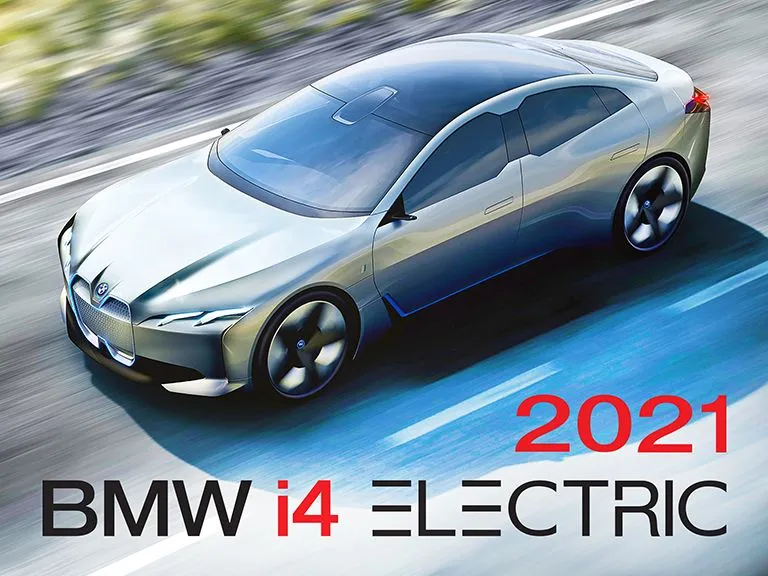
The BMW i4 Gran Coupe Pure Electric will arrive in 2021 with a 350-mile range
Bavarian Motor Works has confirmed it will be releasing new electric cars over the next few years, starting with the iX3, an e-version of the X3 SUV, which will go on sale in 2020. The company has stated it wants to release 25 electrified models by 2025, with 12 of the being pure electric.
By John Coulter, CMO, Current EV
The iX3 will be followed by the i4, a “saloon car” based on the i Vision Dynamics vehicle presented at the Frankfurt Motor Show in 2017. Based on the same platform as the 3-series and 4-series, the i4 will likely have two electric motors providing all-wheel drive – a new power and efficiency-enhancing method many car manufacturers are adopting.
“With the fifth generation of eDrive, our vehicles will be able to drive 550 to 700 kilometres (340-435 miles) on electric power, depending on the model,” says BMW CEO Harald Kruger. “We will achieve this in the BMW i4.”
The low-slung, fully electric sports sedan promises to be the closest competitor yet to the Tesla Model 3, with the added benefit of having the build quality of a seasoned carmaker.
Writer Horatiu Boeriu says on the BMWBlog: “Within the smoothly flowing, neatly aligned progression of the surfaces along the car’s flanks, the new characterization of the window profile is a standout feature of the BMW i Vision Dynamics. This iconic styling cue, which made its debut on the first wave of BMW i models, is depicted here in a fresh, likewise function-led interpretation and also sharpens the identity of the car’s flanks. Their virtually symmetrical form allows all passengers an equally good view out, highlighting the attention paid to the passengers and the shared driving experience in the interior. This is something that will gain further in importance in the future, in particular as far as semi-autonomous and connected driving is concerned.”
“The distinctive driving experience is further enhanced by the full-length glass surface running from the windscreen to the rear window. This heightens the sensation of room and enables a feeling of spaciousness and freedom inside the car that belies its dynamic exterior silhouette. Viewed from the outside, the unbroken roof graphic reinforces the enclosed, modern feel of the exterior thanks to seamless transitions through the front and rear end. Just like the BMW Vision Efficient Dynamics, the new concept aims to be an emotional car that shows BMW’s commitment not only to electric drives but also to emotional design.”
The Bavarian carmaker’s attempts at jump-starting the EV Era have experienced a few hiccups. Even with its range expander, the BMW i3 didn’t go very far (it provides 190 miles total), and the i8 supercar, though incredibly beautiful to look at and fun to drive, only provides 15 pure electric miles, and is higher priced than the most expensive Tesla. Though both the i3 and i8 are technological marvels, they didn’t catch on with the public, as did the Leaf, Volt and Bolt, and other contemporaries. That’s not to say that BMW’s electrifications plans haven’t been successful. The German automaker’s global plug-in sales are set to surpass 500,000 units by 2020.
Says Torquenews.com writer Steve Birkett: “With the vast resources at BMW’s disposal and the experience it has gained developing and manufacturing the BMW i3, the company could be in a great position to mass-produce a compelling long-range EV. Timed well and with the right vehicle, BMW could have a temporary yet significant price advantage over its high-end rivals in the electric segment.”
“Materials for the BMW i3, such as the interior’s eucalyptus wood-paneling, are sustainably sourced and the plants used to manufacture its carbon fiber chassis are primarily powered by hydroelectricity. In BMW Group’s own words, compared to its regular vehicles, ‘producing an i3, from first bolts to final inspection, take 50% less energy and 70% less water.’”
“As a result of the German automaker’s creativity and commitment to sustainable design choices, the BMW i3 won two World Car of the Year awards in 2014, including Green Car of the Year. This coming several years before Tesla announced the Model 3 or GM unveiled the Bolt EV.”
What Birkett points out is that BMW has an excellent opportunity to get it right this time with its next round of electrics.
The i4 looks and sounds futuristic and electric in every regard. BMW says the e-car will be able to go from 0-62mph in under four seconds, and have a top speed of 124mph. Its 350-mile range will put it on a par with Tesla. It will have a fairly conventional shape similar to that of the current 4-series four-door Gran Coupe – considered a classic “saloon car.”
So what’s a saloon car? BMW’s description: “A typically mid to large sized car, built to take passengers and their luggage from A to B, undercover and out of the elements. The modern saloon, as crafted by BMW, offers a great combination of space, styling and security. It's a family car, an executive car and a racecar.”
BMW will begin its second round of EV introductions with a winning body type, building on the large Coupe style they’ve been highly successful with. The new electric version will appeal to many buyers, especially if BMW keeps its price reasonable.
Recent Posts
- The 2022 Audi Q4 e-Tron SUV combines performance, practicality and luxury
- Ford's 2022 F150 Lightning All-Electric Truck is in high demand
- Legendary Audi performance is at the heart of the 2022 Audi e-tron GT and its RS sibling.
- Meet the Lexus RZ 450e – the luxury brand’s 1st EV
- The 2022 GV60 is Genesis’ first all-electric vehicle

